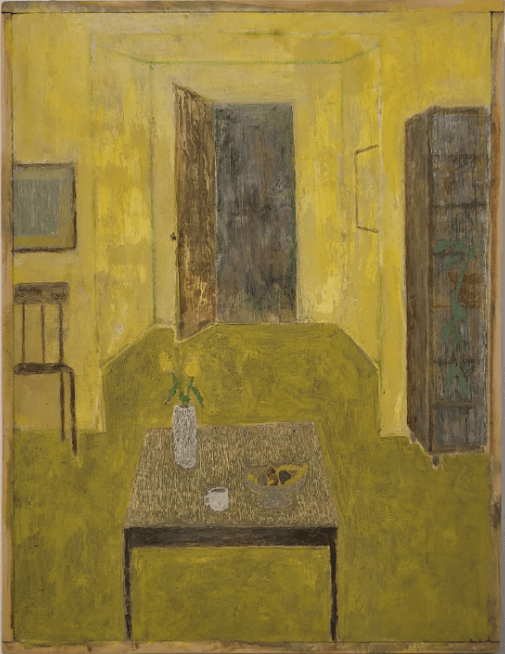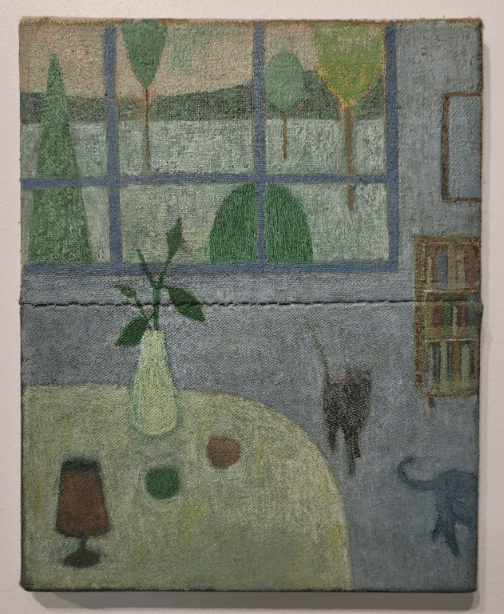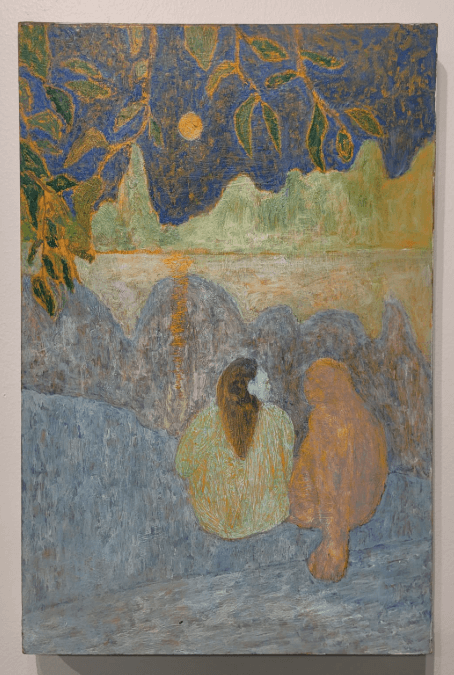Daniel Cabrillos Jacobsen, Yesterday as in Tomorrow, Municipal Bonds
By: Hugh Leeman
Daniel Cabrillos Jacobsen's show, Yesterday as in Tomorrow, of six small oil paintings at Municipal Bonds, invites the viewer's imagination to wander amidst muted tones, flattened shapes, and simplified forms, offering just enough to consider the past without telling us of its details. In detail's absence, the artist allows the rich tactile nature of texture to speak as canvas tooth shows through paint, or the rough fiber of burlap becomes an artifact acting as medium as much as support, and a fraying book cover that appears found at the far edge of memory establishes the fringes of a contemplative landscape.
Cabrillos Jacobsen's artworks recall the paintings of early 20th-century French Impressionist Pierre Bonnard. Jacobsen, like Bonnard, often focuses on the realm just beyond our current place in the picture, past a window on the other side of a threshold, varying applications of paint permit one's eyes to pass through previous layers of paint on a visual journey into the artwork. Bonnard unlike many impressionists would not paint from life instead he would paint from memory [1] and this is where Cabrillo Jacobsen situates the viewer as what pulls one in is not what is in front of us but that which is beyond the doors and windows in an ambiguous space where brushstrokes record the beauty of banality over burlap adhered to canvas, uneven seams, and the fraying book cover lending a sense of confidence from a soul's well worn introspection.
The works share a joy of solitude that consoles the yellowing pages of aged books whose earthy aroma takes us to an era of analog life. Bibliosmia is the pleasant smell caused by the chemical decomposition of binding glue and paper that supports the word's ink, its subtle sensory experience wafting into nostrils, softly whispering, one day I will be no more. Cabrillo Jacobsen's paintings remind us that memories' ultimate eventuality is to be forgotten, yet in their nebulous nature, on a journey to obsolescence, is the space left for imagination.
Such a space for imagination appears in the door in Untitled Yellow Home, where we stand before a modest table that hints at the quotidian through a coffee mug, a bowl of ripening fruit, and a vase with two yellow flowers blending with the monochromatic palette. Untitled Yellow Home shows a brown bookshelf with a plant hardly seen in brown greens, a humble wooden chair with an artwork on the wall, no details shared; it's simply a textured screen to explore. The potential in the painting comes from a vanishing point that borrows the bookshelf's brown and plants' green to construct a void, like a miniature Barnett Newman painting, line down the middle, here, separating the dark space from the door whose tiny knob transmits just enough information to mark the trailhead of what is just after the light. The entryway's orthogonal boundary furthers the effect of focus that the artist frames through a geometric cage rendered in a soft yellow-green, slightly obscured by later layers of ochre, recalling Francis Bacon's use of a similar structure.
Untitled Home arranges a similar scene to Untitled Yellow Home through open space created by a door's frame and the trapezoidal structure of its open door, inviting us into a place, at once certain and barely there. Unlike Untitled Yellow Home, here, after the threshold in the second space, the light is at its best, coming from a nondescript place with structures formed by soft edges heightened by the rounded corners of the canvas. The true call to curiosity is the textured strip of burlap upon which the second room is rendered with its fading details telling of a landscape just past yet another open door, pulling our eyes onto a terrace overlooking the soft topography of hills and a valley below. Eventually our eyes leave the distant topography's texture and return to the foreground, a room in browns the same tone as the unpainted portion of burlap peeks out at the top of the painting as subtle as the wooden wardrobe whose open door suggest the storage chest of mind upon which a vase, once again, supports two yellow flowers all hinting at metaphor through the sequence of open doors.
The pensive atmosphere turns playful in When the Parents Away, the Cats Will Play as cats in soft silhouettes walk across the picture plane. Bonnard added cats to several of his paintings, lending his interiors a relaxed tone. Cabrillo Jacobsen performs a similar act through the cats to challenge the room's muted blues and softly shaped landscape under the dusky light of the sky seen past the wood slats of a window that leaves a lingering sense of contemplating change. Contemplative atmosphere aside, the cats, the title, and division of space between floor and wall created by a sloping seam in the canvas along with Cabrillo Jacobsen's flower vase from which two stems emerge sits all too close to the table's edge alluding to mischief indicating a story that sits untold with the books on the painting's shelf.
Stories like memory shift with time, yet stories' malleability allows the seams of disparate memories' threads to be tied together. In Woman Reading the season shifts as early spring or late fall is rendered just past the window in leafless trees. Comfortably sitting inside, the space's protagonist, face devoid of detail, wears a shirt whose grid pattern, like the tablecloth's squares, visually connects to the several squared seams binding otherwise separate portions of canvas into a coherent whole. The show's recurring motif, a vase from which two yellow flowers emerge, sits atop a table, this time beside two mugs, one red, one blue, and a purple teapot signaling someone might sit, share tea, and a story like those of the countless others sitting on the shelves.
In Moonwatching, the room, its doors and windows left behind, underpainting's orange peeks from beneath a blue-purple sky, highlighting the moon's glow around the edge of leaves. Two figures in conversation, perhaps the fading memory of a first kiss, a distant horizon, and rising moon reflect across the water, story intimately interwoven with memory recalls Oscar Wilde's play The Importance of Being Earnest in which Algernon Moncrieff says, "Memory... is the diary that we all carry about with us."[2]
The stories from such a diary of memory are best told in Nightsky painted on a found book cover whose tattered edges and fraying fabric frame a landscape rich with elements of a Rothko in hand-held size. The book cover's red color vibrates around the border of green trees and through a thin beige wash forming a field all while enriching a purple night sky whose gradation tells the passage of time, a sense redoubled by the stars fading light that having finally reached our eyes carrying memories of places left behind, the ones we'll never know, their abstract truth like stories well told. In six small paintings, Yesterday as in Tomorrow holds the viewer through giving us places that, amidst their muted tones and simplified forms, allow us to set aside distraction and recollect with wonder how fleeting yesterday was and tomorrow will be.
Citations:
1. “The Open Window.” The Phillips Collection, www.phillipscollection.org/collection/open-window.
2. Wilde, Oscar. The Importance of Being Earnest. Boston: W. H. Baker Company, 1920. Baker’s Professional Plays. PDF file. Internet Archive, https://ia601308.us.archive.org/12/items/importanceofbein1920wild/importanceofbein1920wild.pdf.








